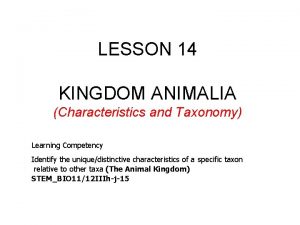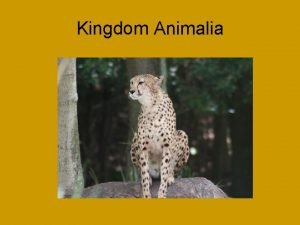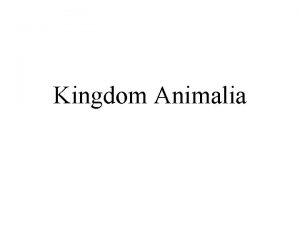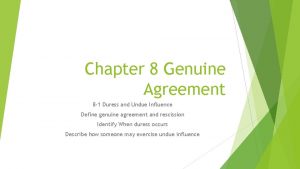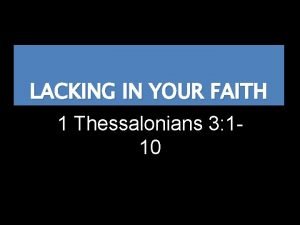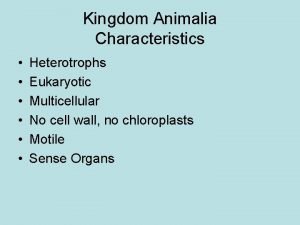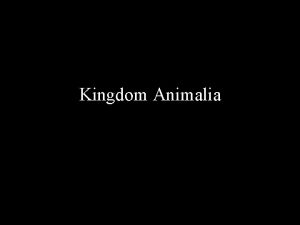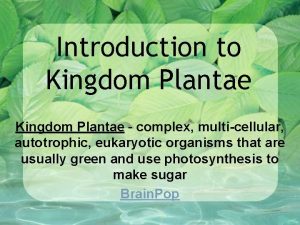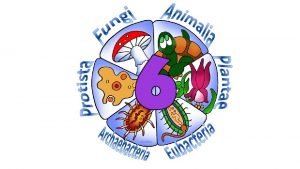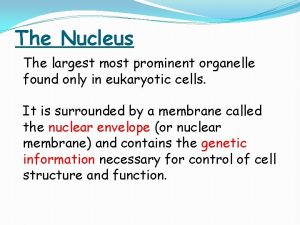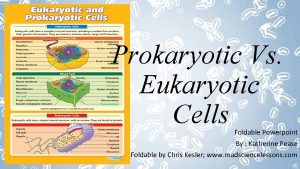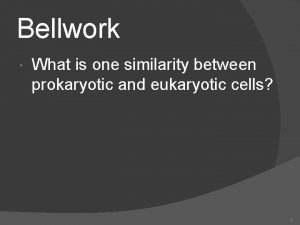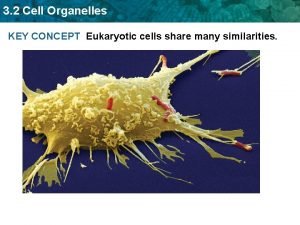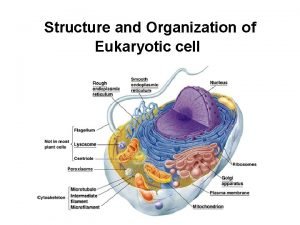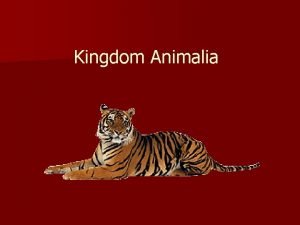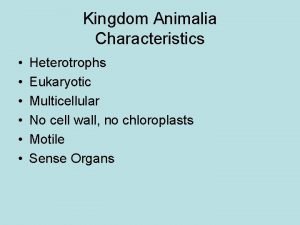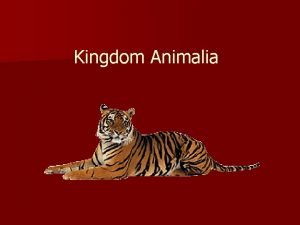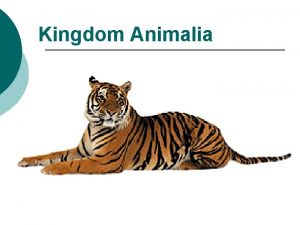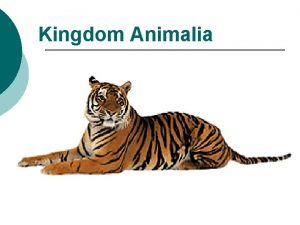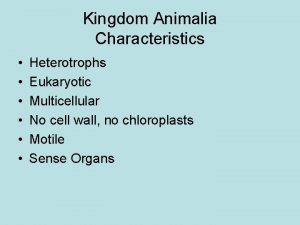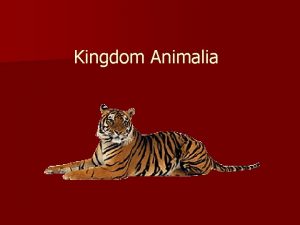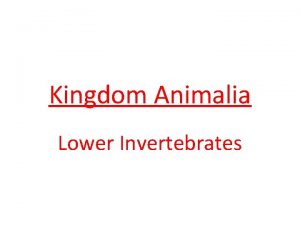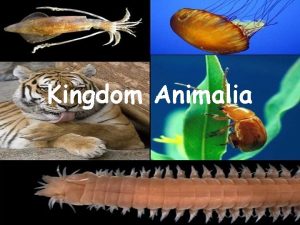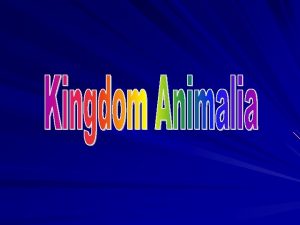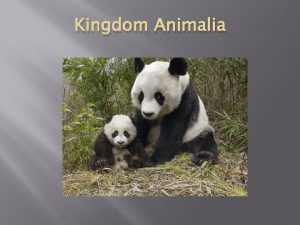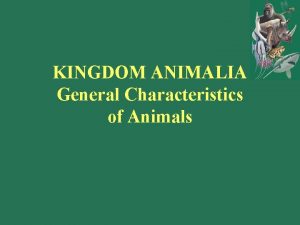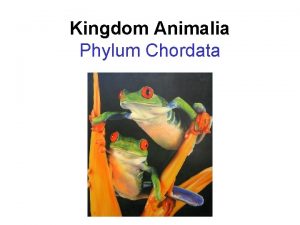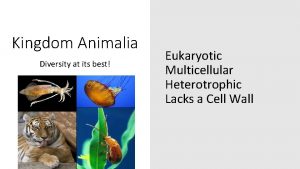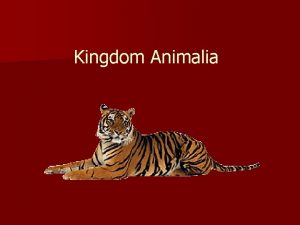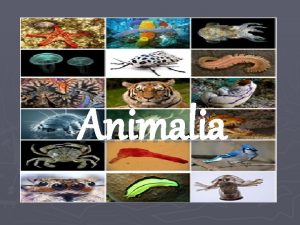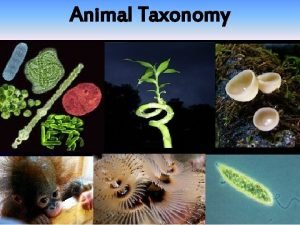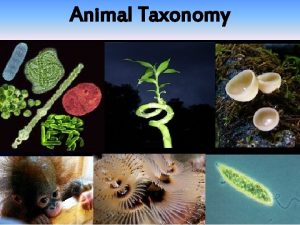Kingdom Animalia Characteristics Multicellular p Eukaryotic cells lacking


























- Slides: 26

Kingdom Animalia


Characteristics Multicellular p Eukaryotic cells lacking cell walls p Diploid (with the gamete being the only haploid cell) p Heterotrophs- digest in an internal cavity (enteron) p Locomotive as they search for food p Develop from an embryonic stage (blastula forms germ layers) p

Zygote to Blastula

Classification based on 1. 2. 3. 4. Symmetry Body layers Body cavities Segmentation

Symmetry

Body layers



Body cavities More advanced organisms have an additional body cavity called coelom- this is a fluid filled space in the mesoderm that divides the muscles of the gut from the body wall. p Coelomic fluid under pressure gives surrounding muscles something to contract against and functions as a hydrostatic skeleton p


Advantages of body plan 1. 2. 3. Peristalsis can be developed Locomotion Development of internal organs

Segmentation p In coelmate animals the mesoderm becomes divided to form small, similar segments (somites)= metameric segmentation

Phylum Cnidaria

Organisms in the phylum Cnidaria p Include sea anemones, jellyfish, corals and freshwater Hydra.

Structure of Hydra p p p p Diploblastic- endoderm and ectoderm (seperated by jelly like mesoglea) Digestive cavity (enteron) is sac like Enteron has only one entrance which, through called the mouth, also serves as the exit for undigested remains Radially symmetrical so can respond to environment through 360˚ Tentacles with stinging cells (cnidocysts) in the ectoderm Body supported by aqueous medium and hydrostatic skeleton formed by fluid filled enteron Often sedentary but can undertake cartwheel movements

Feeding in Hydra p p p Predates live prey such as daphnia When prey touches a cnidocyst, its poison tube with barbs shoots out, impaling the prey Paralysed animal conveyed to mouth and into enteron by tentacles Endodermal cells secrete enzymes so digestion is initiated extracellularly Partially digested food fragments are ingested into endodermal cells by endocytosis and digestion is completed intracellularly by lysosomes Undigested food egested through the mouth

Phylum Platyhelminthes (AKA Flatworms)

Structure of Planarian (a platyhelminth) Triploblastic p No coelum (acoelmoate) p Dorso-ventrally flattered =large SA: V p Gut cavity has single opening p Branched gut (reaches all parts of body) p No circulatory system p Bilaterally symmetrical p Supported by aqueous medium although mesoderm has a supportive role p Gliding movements by cilia p

Feeding in a Planarian p p p Most are detrivores but some are carnivores Once in contact with food, they evert a pharynx by which food is taken to the gut Enzymes secreted so initial digestion is extracellular Partly digested fragments ingested by endodermal cells and digestion is completed intracellularly Highly divided gut means short transport distances Undigested food excreted through mouth


Phylum Annelida

Structure of an earthworm p p p p Triploblastic Coelomate Coelom is large and filled with fluid= hydrostatic skeleton and room for development Through gut with mouth and anus Bilaterally symmetrical Metamerically segmented Locomotion via chaetae Long and thin to allow for ease of movement


Feeding in an Earthworm p p p p Detrivores Ingested via mouth One way gut- food drawn into a muscular pharynx, along oesophagus to be stored in the crop, slowly released into the muscular gizzard where it is crushed, then digested and absorbed in the intestine. Allows food to be ingested continually Digestion is completed in the gut (extracellularly) Products of digestion are absorbed into and distributed b a well developed blood system Undigested material excreted through anus = worm casts.

Animal Development Crash Course Clip 11. 5 mins
 Kingdom plantae prokaryotic or eukaryotic
Kingdom plantae prokaryotic or eukaryotic Eukaryotic life
Eukaryotic life Prokaryotes vs eukaryotes venn diagram
Prokaryotes vs eukaryotes venn diagram Are plant cells prokaryotic or eukaryotic
Are plant cells prokaryotic or eukaryotic Prokaryotic cell wall
Prokaryotic cell wall The mcgraw-hill
The mcgraw-hill Animalia characteristics
Animalia characteristics Characteristics of animals
Characteristics of animals Old kingdom middle kingdom new kingdom
Old kingdom middle kingdom new kingdom Nnn ruled
Nnn ruled Youtube
Youtube Capital of egypt during the old kingdom
Capital of egypt during the old kingdom Duress occurs when
Duress occurs when Sadlier unit 1 level d synonyms
Sadlier unit 1 level d synonyms Perfect that which is lacking in your faith
Perfect that which is lacking in your faith Perfect that which is lacking in your faith
Perfect that which is lacking in your faith Are animalia heterotrophs
Are animalia heterotrophs Automorphic trait
Automorphic trait A multicellular autotrophic organism with vascular tissue
A multicellular autotrophic organism with vascular tissue Is eubacteria multicellular or unicellular
Is eubacteria multicellular or unicellular Most prominent organelle in eukaryotic cells
Most prominent organelle in eukaryotic cells Eukaryotic cells
Eukaryotic cells Three parts of cell theory
Three parts of cell theory Is protist a prokaryote or eukaryote
Is protist a prokaryote or eukaryote Similarity between prokaryotic and eukaryotic cells
Similarity between prokaryotic and eukaryotic cells Organelles in eukaryotic cells worksheet
Organelles in eukaryotic cells worksheet Eukaryotic cells
Eukaryotic cells





